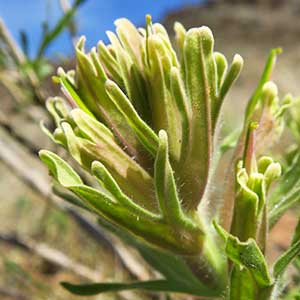Castilleja litoralis
Castilleja xanthotricha
coast paintbrush, Oregon coast paintbrush, Pacific paintbrush
John Day or yellow-hairy paintbrush, John Day paintbrush, yellow hair paintbrush, yellow-hair Indian paintbrush
few to many, usually decumbent proximally, becoming ascending-erect, sometimes ascending, branched, sometimes with small, leafy axillary shoots, glabrate or ± pubescent distally, hairs sparse to moderately dense, spreading to ± appressed, short, soft, sometimes mixed with short-glandular ones below inflorescence.
few to several, ± decumbent to erect or ascending, unbranched, sometimes with short, leafy axillary shoots, hairs erect to spreading, long, soft, eglandular, mixed with short stipitate-glandular ones.
green, lanceolate to oblong or narrowly ovate, (0.5–)3–8 cm, sometimes thickened, not fleshy, margins plane, sometimes ± wavy, flat to involute, 0(–3)-lobed, apex acute to rounded;
lobes ascending or spreading, linear, narrowly lanceolate to oblong or triangular, short, apex acute to obtuse.
green, linear, lanceolate to broadly lanceolate, oblong, or cuneate, 0.8–5 cm, not fleshy, margins plane to wavy, involute, 0–5-lobed, apex acute, sometimes rounded;
lobes spreading, linear, arising below mid length, nearly as broad as center lobe, apex acute.
2.5–21 × 3–5 cm;
bracts proximally green, distally bright red to crimson or orange-red, sometimes orange or pale yellow-orange, oblong to narrowly ovate or narrowly obovate, (0–)3–5-lobed, sometimes with a pair of small teeth;
lobes ascending, linear to oblong, medium length, arising in middle 1/3, central lobe apex obtuse to rounded or truncate, lateral ones ± acute.
3–14 × 1.5–4.5 cm;
bracts proximally greenish, rarely dull reddish purple, distally white to cream, rarely pale yellow or dull, pale pink (sharply differentiated from proximal coloration), lanceolate or oblong to narrowly ovate, (3–)5–7-lobed;
lobes ascending, linear to obovate, ± broadened distally, medium, long, proximal lobes arising below mid length, central lobe apex broadly rounded to truncate, others acute to rounded.
0–6 mm.
straight or slightly curved, 23–38(–40) mm;
tube 10–20 mm;
abaxial lip often visible through front cleft, very rarely almost exserted, beak exserted;
beak adaxially green or yellowish, 10–16 mm, surface inconspicuously puberulent;
abaxial lip ascending, green, reduced, 1–2.5 mm, 10–20% as long as beak;
teeth erect or incurved, green or white, 1–2 mm.
curved, 17–23 mm;
tube 15–19 mm;
beak exserted, adaxially green, 5–8(–9) mm, puberulent, stipitate-glandular;
abaxial lip deep purple (color sometimes visible through calyx), green, pinkish, or pale yellow, ± prominent, slightly inflated, usually hidden in calyx, sometimes right at top of calyx, 2 mm, ca. 50% as long as beak;
teeth ascending, whitish, yellowish, pink, or green, 1–1.5 mm.
colored as bracts, 17–25(–30) mm;
abaxial and adaxial clefts (5–)7–15(–18) mm, 33–55% of calyx length, deeper than laterals, lateral 1–3(–5) mm, 5–10% of calyx length;
lobes broadly triangular to oblong, apex obtuse to acute or rounded.
colored as bracts, 15–26 mm;
abaxial and adaxial clefts 3.5–7 mm, 25–50% of calyx length, deeper than laterals, lateral 2–5 mm, 12–25% of calyx length;
lobes linear, oblong, or narrowly triangular, center lobe apex usually rounded, lobes acute to rounded.
= 120, 144.
= 48.
Castilleja litoralis
Castilleja xanthotricha
Castilleja litoralis never ranges more than one to two kilometers from the sea, from Humboldt County, California, north to Pacific County, Washington, near the mouth of the Columbia River. It is a high polyploid complex, possibly incorporating the genomes of several species, including C. affinis, C. miniata, and possibly C. hispida. The coastal C. miniata var. dixonii is very similar ecologically and morphologically but replaces C. litoralis from southwestern Washington to southern British Columbia. Compared to C. litoralis, C. miniata var. dixonii usually has somewhat longer corollas and corolla beaks, the latter with a more conspicuously puberulent surface and deeper lateral calyx clefts. Castilleja litoralis has been included as a subspecies of C. affinis by some (for example, M. Wetherwax et al. 2012), but the morphological resemblance to that species is far more tenuous than it is to C. miniata var. dixonii. Considering their very similar morphologies, along with the fact that both C. litoralis (2n = 120, 144) and C. miniata var. dixonii (2n = 96, 144) apparently combine multiple genomes, strongly suggest that they would best be treated as a single entity. Should they be combined at the species level following additional research, the name C. dixonii has priority.
Castilleja litoralis is often associated with salal, Gaultheria shallon, on which it is likely parasitic.
(Discussion copyrighted by Flora of North America; reprinted with permission.)
Castilleja xanthotricha is endemic to moderate elevations in the sagebrush hills of the John Day River drainage in north-central Oregon. N. H. Holmgren (1971) hypothesized that this tetraploid species is of allopolyploid hybrid origin between C. glandulifera and C. oresbia.
(Discussion copyrighted by Flora of North America; reprinted with permission.)
- Local floras:
CA,
OR,
WA
- Local Web sites:
CalFlora,
CalPhotos,
Flora NW,
PNW Herbaria
WildflowerSearch
iNaturalist (observations)
USDA Plants Database
- LBJ Wildflower Center
- SEINet
- Plants of the World Online
- Encyclopedia of Life
- Wikipedia
- Google Image Search


